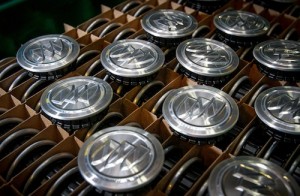 General Motors has revealed details about how it plans to increase its margin to 10% in 2016, with cuts in material and logistics costs making up a large part of the company’s savings in regions including North America and South America.
General Motors has revealed details about how it plans to increase its margin to 10% in 2016, with cuts in material and logistics costs making up a large part of the company’s savings in regions including North America and South America.
During an investor meetings last week in Michigan, the company’s chief executive officer, Mary Barra, said that the company will reduce material and logistics costs specifically by around $2.5 billion over the next two years. In North America alone, she said that GM would save $900m in both 2015 and 2016 in logistics costs.
The plans are part of larger aims that include product and technology advances, a reduction in production platforms, targeted growth in China and the establishment of Cadillac as a separate business unit to pursue growth in the luxury market. GM also expects to return to profit in Europe by 2016. Margins are targeted to grow from around 8.5% in recent years to 10% by 2016.
Barra said the company aims to improve relationships with suppliers and derive more global volume from fewer vehicle architectures. By 2020, the company expects that about 99% of global production will be on core architectures.
To deliver better margins on forthcoming high-volume product launches, including the Opel/Vauxhall Corsa and Astra, and the Chevrolet Cruze and Malibu in North America, the company said it needed to lower enterprise costs for material and logistics.
Last year, Grace Leiblein, vice-president of global purchasing and supply chain (GPSC), made clear the company’s intention to reduce logistics expenditure. She said that the company would trim its multi-billion dollar global logistics budget over the coming years by brining suppliers closer to assembly and investing in logistics infrastructure at plants, amongst other plans.
The finer points of that strategy were detailed by Edgar Pezzo, executive director of global logistics and containerisation, in the most recent edition of Automotive Logistics magazine (www.automotivelogisticsmagazine.com/interview/general-motors-waste-not-want-not). Pezzo has moved logistics to the fore in overall model planning and development. Central to that is the elimination of waste and this involves changes to material order processes as a way of eliminating extra inventory and making routes more efficient.
(The strategy was also raised by Marzell Bandur, director of supply chain planning at GM’s Opel division at the Automotive Logistics Europe conference held in the early part of this year.)
Beyond total enterprise cost
GM has been pursuing a policy of ‘total enterprise cost’ for some years now, which has meant early consideration of supply chain costs and operations starting from vehicle development, including packaging requirements, supply breakpoints and long-distance transport and inventory costs.
Pezzo said that while that was still a focus, spending had changed because of increasing fuel, trucking and other logistics costs. GM’s logistics experts are now working even more closely with suppliers and the company’s global purchasing department to lower material and logistics costs.
That tightening of collaboration in planning has three main strategies: working with purchasing to better position suppliers taking into account global platforms’ working with manufacturing to ensure the best infrastructure is in place close to the plants; and working with purchasing to localise as many suppliers as possible, especially in areas where there is a high imported content.
Pezzo said that it is up to logistics teams to understand the requirements of design, sourcing and manufacturing to ensure that logistics can support and influence those areas.
“Logistics is a very important part of the whole system,” Pezzo told Automotive Logistics. “If we work upfront with our colleagues internally to optimise our network, we will contribute to the company’s success, profits and overall objectives. The very fact that senior management is putting so much focus on logistics shows how important it really is at GM.”
Read the full feature with Edgar Pezzo which details how GM is reducing material and logistics costs here





































